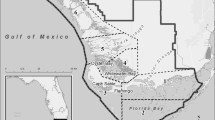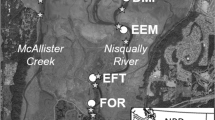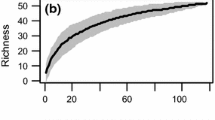Abstract
The presence of relatively rare species in estuarine fish communities can influence niche differentiation among species, functional redundancy, and ecosystem stability when faced with environmental disturbance. In southeastern Florida, at least four species of snook (Centropomidae) occur in coastal river systems, but only one species occurs elsewhere in the state. To better understand how these species can co-occur, we analyzed data from electrofishing and diet studies conducted during 2007–2010 to investigate niche partitioning between two species: Common Snook Centropomus undecimalis and Smallscale Fat Snook Centropomus parallelus (common and fat snook hereafter). Although the diets of the two species collected from coastal rivers were barely distinguishable, there was separation of habitat use. Adult fat snook had affinities for low salinity portions of rivers, while common snook were distributed more widely. Use of nursery habitat by fat snook occurred during early spring, confirming winter spawning, which contrasts with the protracted spawning of common snook that occurs spring through fall. While in riverine nurseries, juvenile fat snook occupied shallow to moderate depths with cover (e.g., woody debris, docks); common snook had greater affinity for shallow natural shorelines (e.g., mangroves, aquatic macrophytes). Overall, fat snook appeared to occupy niches left open by the generalist common snook. Considering that centropomids are likely to expand their range northward in Florida with climate change, understanding habitat use and niche partitioning among the species may help predict which species is likely to expand first and what habitat types will be occupied.







Similar content being viewed by others
Change history
18 December 2019
In the original version of the article there was an error during the production of Fig. 3.
References
Barbour, A.B., A.J. Adams, and K. Lorenzen. 2014. Size-based, seasonal, and multidirectional movements of an estuarine fish species in a habitat mosaic. Marine Ecology Progress Series 507: 263–276.
Barón-Aguilar, C.C., N.R. Rhody, N.P. Brennan, K.L. Main, E.B. Peebles, and F.E. Muller-Karger. 2013. Influence of temperature on yolk resorption in common snook Centropomus undecimalis (Bloch, 1792) larvae. Aquaculture Research 2013: 1–9.
Blewett, D.A., and P.W. Stevens. 2014. Temperature variability in a sub-tropical estuary and implications for common snook Centropomus undecimalis. Gulf of Mexico Science 1: 44–54.
Blewett, D.A., R.A. Hensley, and P.W. Stevens. 2006. Feeding habits of common snook, Centropomus undecimalis, in Charlotte Harbor, Florida. Gulf and Caribbean Research 18: 1–13.
Blewett, D.A., P.W. Stevens, and J. Carter. 2017. River flooding affects abundance and body condition of a large euryhaline fish. Marine Ecology Progress Series 563: 211–218.
Boucek, R.E., and J.S. Rehage. 2013. No free lunch: displaced marsh consumers regulate a prey subsidy to an estuarine consumer. Oikos 122: 1453–1464.
Boucek, R.E., and J.S. Rehage. 2014. Examining the effectiveness of consumer diet sampling as a nonnative detection tool in a subtropical estuary. Transactions of the American Fisheries Society 143: 489–494.
Bovee, K. D. 1986. Development and evaluation of habitat suitability criteria for use in the instream flow incremental methodology. Instream Flow Information Paper 21. U.S. Fish and Wildlife Service Biological Report 86(7). 235 pp.
Burkhardt, R.W., and S. Gutreuter. 1995. Improving electrofishing catch consistency by standardizing power. North American Journal of Fisheries Management 15: 375–381.
Clarke, K.R., and R.N. Gorley. 2006. PRIMER v6: User Manual/Tutorial. PRIMER-E. Plymouth. 190.
Clarke, K.R., and R.M. Warwick. 2001. Change in marine communities: an approach to statistical analysis and interpretation. 2nd ed. Plymouth: PRIMER-E.
da Silva, V.E.L., and N.N. Fabré. 2019. Rare species enhance niche differentiation among tropical estuarine fish species. Estuaries and Coasts 42 (3): 890–899. https://doi.org/10.1007/s12237-019-00524-2.
Daros, F.A., H.L. Spach, and A.T. Correia. 2016. Habitat residency and movement patterns of Centropomus parallelus juveniles in a subtropical estuarine complex. Journal of Fish Biology 88: 1796–1810.
Deaton, L.E., and M.J. Greenberg. 1986. There is no horohalinicum. Estuaries 9: 20–30.
Dutka-Gianelli, J. 2010. Life history and ecology of the Smallscale Fat Snook, Centropomus parallelus (Centropomidae) in east central Florida, and methodology to identify the regional snook species. Doctoral dissertation. Florida Institute of Technology, Melbourne.
Dutka-Gianelli, J. 2014. Feeding habits of the smallscale fat snook from east-central Florida. Transactions of the American Fisheries Society 143: 1199–1203.
Dutterer, A.C., and M.S. Allen. 2008. Spotted sunfish habitat selection at three Florida rivers and implications for minimum flows. Transactions of the American Fisheries Society 137: 454–466.
Elmqvist, T., C. Folke, M. Nystrom, G. Peterson, J. Bengtsson, B. Walker, and J. Norberg. 2003. Response diversity, ecosystem change, and resilience. Frontiers in Ecology and the Environment 1: 488–494.
Ferreira, G.V.B., M. Barletta, and A.R.A. Lima. 2019. Use of estuarine resources by top predator fishes. How do ecological patterns affect rates of contamination by microplastics. Science of the Total Environment 655: 292–304.
Gassman, J., H.R. López, and D. Padrón. 2017. Reproduction of Centropomus undecimalis and C. ensiferus (Perciformes: Centropomidae) in a tropical coastal lagoon. Revista de Biología Tropical 65: 181–194.
Gilmore, G.R. 1995. Environmental and biogeographic factors influencing ichthyofaunal diversity: Indian River Lagoon. Bulletin of Marine Science 57: 153–170.
Gilmore, R.G., C.J. Donahoe, and D.W. Cooke. 1983. Observations on the distribution and biology of the common snook, Centropomus undecimalis (Bloch). Florida Scientist 46: 313–336.
Gonzalez, J.G., F. Ménard, F. Le Loc’h, H.A. de Andrade, A.P. Viana, V. Ferreira, F.L. Frédou, A.S. Lira, J. Munaron, and T. Frédou. 2019. Trophic resource partitioning of two snook species (Centropomidae) in tropical estuaries in Brazil as evidenced by stable isotope analysis. Estuarine, Coastal and Shelf Science 226: 106287.
Greenacre, M.J. 1994. Multiple and joint correspondence analysis. In Correspondence Analysis in the Social Sciences, ed. M.J. Greenacre and J. Blasius, 141–161. London: Academic Press.
Hernández-Vidal, U., Chiappa-Carrara, and W. Contreras-Sánchez. 2014. Reproductive variability of the common snook, Centropomus undecimalis, in environments of contrasting salinities interconnected by the Grijalva-Usumacinta fluvial system. Ciencias Marinas 40: 173–185.
Howells, R.G., A.J. Sonski, P.L. Shafland, and B.D. Hilton. 1990. Lower temperature tolerance of snook, Centropomus undecimalis. Northeast Gulf Science 11: 155–158.
Idelberger, C.F., and M.F.D. Greenwood. 2005. Seasonal variation in fish assemblages within the estuarine portions of the Myakka and Peace rivers, southwest Florida. Gulf of Mexico Science 23: 224–240.
Kodra, E., K. Steinhaeuser, and A.R. Ganguly. 2011. Persisting cold extremes under 21st century warming scenarios. Geophysical Research Letters 38: 1–5.
Kupschus, S., and D. Tremain. 2001. Associations between fish assemblages and environmental factors in nearshore habitats of a subtropical estuary. Journal of Fish Biology 58: 881–889.
Lira, A.S., F.L. Frédou, A.P. Viana, L.N. Eduardo, and T. Frédou. 2017. Feeding ecology of Centropomus undecimalis (Bloch, 1792) and Centopomus parallelus (Poey, 1860) in two tropical estuaries in Northeastern Brazil. Pan-American Journal of Aquatic Sciences 12: 123–135.
Markham, J. 2014. Rare species occupy uncommon niches. Scientific Reports 4: 6012. https://doi.org/10.1038/srep06012.
McMichael, R.H., Jr., K.M. Peters, and G.R. Parsons. 1989. Early life history of the snook, Centropomus undecimalis, in Tampa Bay, Florida. Northeast Gulf Science 10: 112–125.
Mouillot, D., D.R. Bellwood, C. Baraloto, J. Chave, R. Galzin, M. Harmelin-Vivien, M. Kulbicki, S. Lavergne, S. Lavorel, N. Mouquet, C.E.T. Paine, J. Renaud, and W. Thuiller. 2013. Rare species support vulnerable functions in high- diversity ecosystems. PLoS Biology 11: e1001569.
Nelson, J.S., E.J. Crossman, H. Espinosa-Perez, L.T. Findley, C.R. Gilbert, R.N. Lea, and J.D. Williams. 2004. Common and scientific names of fishes from the United States, Canada, and Mexico. 6th ed. Bethesda: American Fisheries Society (Special Publication 29).
Newbrey, M.G., M.A. Bozek, M.J. Jennings, and J.E. Cook. 2005. Branching complexity and morphological characteristics of coarse woody structure as lacustrine fish habitat. Canadian Journal of Fisheries and Aquatic Sciences 62: 2110–2123.
Osland, M.J., N. Enwright, R.H. Day, and T.W. Doyle. 2013. Winter climate change and coastal wetland foundation species: salt marshes vs. mangrove forests in the southeastern United States. Global Change Biology 19: 1482–1494.
Osland, M.J., A.M. Hartmann, R.H. Day, M.S. Ross, C.T. Hall, L.C. Feher, and W.C. Vervaeke. 2019. Microclimate influences mangrove freeze damage: implications for range expansion in response to changing macroclimate. Estuaries and Coasts 42 (4): 1084–1096. https://doi.org/10.1007/s12237-019-00533-1.
Paperno, R., J. Dutka-Gianelli, and D. Tremain. 2018. Seasonal variation in nekton assemblages in tidal and nontidal tributaries in a barrier island lagoon system. Estuaries and Coasts 41: 1821–1833.
Perera-García, M.A., M. Mendoza-Carranza, W.M. Contreras-Sánchez, M. Huerta-Ortíz, and E. Pérez-Sánchez. 2011. Reproductive biology of common snook Centropomus undecimalis (Perciformes: Centropomidae) in two tropical habitats. Revista de Biología Tropical 59: 669–681.
Peters, K.M., R.E. Matheson Jr., and R.G. Taylor. 1998. Reproduction and early life history of common snook, Centropomus undecimalis (Bloch), in Florida. Bulletin of Marine Science 62: 509–529.
Pickett, S.T.A., and P.S. White. 1985. The ecology of natural disturbance and patch dynamics. Orlando: Academic Press.
Rivas, L.R. 1986. Systematic review of the perciform fishes of the genus Centropomus. Copeia 1986: 579–611.
SAS Institute, Inc. 2009. The CORRESP procedure. http://support.sas.com/documentation/cdl/en/statug/59654/HTML/default/corresp_toc.htm Accessed 11/18/2019.
Scharf, F.S., and K.K. Schlicht. 2000. Feeding habits of red drum (Sciaenops ocellatus) in Galveston Bay, Texas: Seasonal diet variation and predator–prey size relationships. Estuaries 23: 128–139.
Schindler, D.E., J.B. Armstrong, and T.E. Reed. 2015. The portfolio concept in ecology and evolution. Frontiers in Ecology and the Environment 13: 257–263.
Stevens, P.W., D.A. Blewett, and G.R. Poulakis. 2007. Variable habitat use by juvenile common snook, Centropomus undecimalis (Pisces: Centropomidae): applying a life-history model in a southwest Florida estuary. Bulletin of Marine Science 80: 93–108.
Stevens, P.W., D.A. Blewett, T.R. Champeau, and C.J. Stafford. 2010a. Posthurricane recovery of riverine fauna reflected in the diet of an apex predator. Estuaries and Coasts 33: 59–66.
Stevens, P.W., M.F.D. Greenwood, and C.F. Idelberger. 2010b. Mainstem and backwater fish assemblages in the tidal Caloosahatchee River: implications for freshwater inflow studies. Estuaries and Coasts 33: 1216–1224.
Stevens, P.W., M.F.D. Greenwood, and D.A. Blewett. 2013. Fish assemblages in the oligohaline stretch of a southwest Florida river during periods of extreme freshwater inflow variation. Transactions of the American Fisheries Society 142: 1644–1658.
Stevens, P.W., D.A. Blewett, R.E. Boucek, J.S. Rehage, B.L. Winner, J.M. Young, J.A. Whittington, and R. Paperno. 2016. Resilience of a tropical sport fish population to a severe cold event varies across five estuaries in southern Florida. Ecosphere 7 (8): e01400. https://doi.org/10.1002/ecs2.1400.
Stevens, P.W., R.E. Boucek, A.A. Trotter, J.L. Ritch, E.R. Johnson, C.P. Shea, D.A. Blewett, and J.S. Rehage. 2018. Illustrating the value of cross-site comparisons: Habitat use by a large, euryhaline fish differs along a latitudinal gradient. Fisheries Research 208: 42–48.
Taylor, R.G., H.J. Grier, and J.A. Whittington. 1998. Spawning rhythms of common snook in Florida. Journal of Fish Biology 53: 502–520.
Taylor, R.G., J.A. Whittington, H.J. Grier, and R.E. Crabtree. 2000. Age, growth, maturation, and protandric sex reversal in common snook, Centropomus undecimalis, from the east and west coasts of South Florida. Fishery Bulletin 98: 612–624.
Teichert, N., M. Lepage, A. Sagouis, A. Borja, G. Chust, M.T. Ferreira, S. Pasquaud, R. Schinegger, P. Segurado, and C. Argillier. 2017. Functional redundancy and sensitivity of fish assemblages in European rivers, lakes and estuarine ecosystems. Scientific Reports 7: 1–11.
Trotter, A.A., D.A. Blewett, R.G. Taylor, and P.W. Stevens. 2012. Migrations of common snook from a tidal river with implications for skipped spawning. Transactions of the American Fisheries Society 141: 1016–1025.
Van der Putten, W.H., M. Macel, and M.E. Visser. 2010. Predicting species distribution and abundance responses to climate change: why it is essential to include biotic interactions across trophic levels. Philosophical Transactions of the Royal Society B 365: 2025–2034. https://doi.org/10.1098/rstb.2010.0037.
Vilizzi, L. 2002. Modelling preference curves for the study of fish habitat use. Archiv für Hydrobiologie 155: 615–626.
Violle, C., W. Thuiller, N. Mouquet, F. Munoz, N.J.B. Kraft, M.W. Cadotte, S.W. Livingstone, and D. Mouillot. 2017. Functional rarity: the ecology of outliers. Trends in Ecology & Evolution 32: 356–367.
Vismara, R., A. Azzellino, R. Bosi, G. Crosa, and G. Gentili. 2001. Habitat suitability curves for brown trout (Salmo trutta Fario L.) in the river Adda, Northern Italy: comparing univariate and multivariate approaches. Regulated Rivers: Research and Management 17: 37–50.
Waters, D.S., T.J. Kwak, J.B. Arnott, and W.E. Pine III. 2004. Evaluation of stomach tubes and gastric lavage for sampling diets from blue catfish and flathead catfish. North American Journal of Fisheries Management 24: 258–261.
Whitfield, A.K., M. Elliott, A. Basset, S.J.M. Blaber, and R.J. West. 2012. Paradigms in estuarine ecology: a review of the Remane diagram with a suggested revised model for estuaries. Estuarine, Coastal and Shelf Science 97: 78–90.
Winner, B.L., D.A. Blewett, R.H. McMichael Jr., and C.B. Guenther. 2010. Relative abundance and distribution of Common Snook along shoreline habitats of Florida estuaries. Transactions of the American Fisheries Society 139: 62–79.
Young, J.M., B.G. Yeiser, and J.A. Whittington. 2014. Spatiotemporal dynamics of spawning aggregations of common snook on the east coast of Florida. Marine Ecology Progress Series 505: 227–240.
Acknowledgments
We thank A. Berry, L. Bivins, G. Coldwell, J. Kerns, L. LoBello, S. Marsh, J. Morehead, K. Nault, N. Trippel, W. Strong, B. Yeiser, and J. Young for their field and laboratory contributions to this project. Access databases were created by K. Rodgers, R. Kiltie provided statistical assistance, and J. Ritch created maps.
Funding
Field sampling and data analysis were supported with funds collected from the State of Florida Saltwater Fishing License sales, US Department of the Interior, US Fish and Wildlife Service, Federal Aid for Sport Fish Restoration to the Florida Fish and Wildlife Commission.
Author information
Authors and Affiliations
Corresponding author
Additional information
Communicated by Henrique Cabral
The original version of this article was revised: In the original version of the article there was an error during the production of Fig. 3.
Electronic Supplementary material
ESM 1
(DOCX 768 kb)
Rights and permissions
About this article
Cite this article
Stevens, P.W., Dutka-Gianelli, J., Nagid, E.J. et al. Niche Partitioning Among Snook (Pisces: Centropomidae) in Rivers of Southeastern Florida and Implications for Species Range Limits. Estuaries and Coasts 43, 396–408 (2020). https://doi.org/10.1007/s12237-019-00650-x
Received:
Revised:
Accepted:
Published:
Issue Date:
DOI: https://doi.org/10.1007/s12237-019-00650-x




